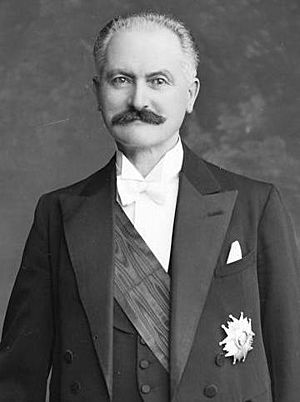Albert Lebrun facts for kids
Quick facts for kids
Albert Lebrun
|
|
|---|---|

Lebrun in 1932
|
|
| President of France | |
| In office 10 May 1932 – 11 July 1940 |
|
| Prime Minister | |
| Preceded by | Paul Doumer |
| Succeeded by | Philippe Pétain (Chief of the French State) |
| President of the Senate | |
| In office 11 June 1931 – 10 May 1932 |
|
| Preceded by | Paul Doumer |
| Succeeded by | Jules Jeanneney |
| Minister of the Liberated Regions | |
| In office 23 November 1917 – 6 November 1919 |
|
| Prime Minister | Georges Clemenceau |
| Preceded by | Charles Jonnart |
| Succeeded by | André Tardieu |
| Minister of the Colonies | |
| In office 9 December 1913 – 3 June 1914 |
|
| Prime Minister | Gaston Doumergue |
| Preceded by | Jean Morel |
| Succeeded by | Maurice Maunoury |
| In office 27 June 1911 – 12 January 1913 |
|
| Prime Minister | Joseph Caillaux Raymond Poincaré |
| Preceded by | Adolphe Messimy |
| Succeeded by | René Besnard |
| Minister of War | |
| In office 12 January 1913 – 20 January 1913 |
|
| Prime Minister | Raymond Poincaré |
| Preceded by | Alexandre Millerand |
| Succeeded by | Eugène Étienne |
| President of the General Council of Meurthe-et-Moselle | |
| In office 20 August 1906 – 10 May 1932 |
|
| Preceded by | Alfred Mézières |
| Succeeded by | Albert Tourtel |
| Personal details | |
| Born | 29 August 1871 Mercy-le-Haut, Meurthe-et-Moselle, France |
| Died | 6 March 1950 (aged 78) 16th arrondissement of Paris, Paris, France |
| Cause of death | Pneumonia |
| Political party | Democratic Republican Alliance |
| Spouse | Marguerite Nivoit |
| Children | 2 |
| Alma mater | École polytechnique École des mines de Paris |
Albert François Lebrun (born August 29, 1871 – died March 6, 1950) was a French politician. He served as the President of France from 1932 to 1940. He was the very last president of the Third Republic, which was the government of France for many years. He belonged to a political group called the Democratic Republican Alliance.
Contents
Biography
Early Life and Education
Albert Lebrun was born into a farming family in a place called Mercy-le-Haut in France. He was a very bright student. He went to two important schools, the École Polytechnique and the École des Mines de Paris. He finished at the top of his class in both. After school, he worked as an engineer, helping to plan and build mines in cities like Vesoul and Nancy. But when he was 29, he decided to change careers and enter politics.
Starting in Politics
In 1900, Albert Lebrun became a member of the French Parliament, called the Chamber of Deputies. He was part of the Left Republican Party. Over the years, he held several important jobs in the government.
- From 1912 to 1914, he was the Minister for the Colonies. This meant he was in charge of France's overseas territories.
- In 1913, he briefly served as the Minister of War, overseeing the country's military.
- From 1917 to 1919, he was the Minister for Liberated Regions. This role involved helping areas of France that had been freed after World War I.
Later, he joined a different political group called the Democratic Alliance. In 1920, he was elected to the French Senate, which is another part of the French Parliament. He served as the Vice President of the Senate from 1925 to 1929. Then, from 1931 to 1932, he became the President of the Senate.
Becoming President of France
Albert Lebrun became President of France in 1932. This happened after the previous president, Paul Doumer, was sadly assassinated. Lebrun was re-elected in 1939. People liked him because he was good at working with different political groups. However, as president, he didn't have a lot of direct power.
In June 1940, during World War II, France was facing a very difficult time. The country's military was struggling. Lebrun felt that continuing the fight was pointless. The government decided to ask for a ceasefire with Germany. The Prime Minister at the time, Paul Reynaud, resigned. He suggested that President Lebrun appoint Marechal Philippe Pétain as the new Prime Minister, which Lebrun did.
On July 10, 1940, a new law was passed by the National Assembly, which allowed Prime Minister Pétain to create a new government system. The next day, on July 11, Albert Lebrun was replaced by Pétain as the head of state.
After this, Lebrun went to a town called Vizille. But in August 1943, the Germans captured him and sent him to a castle called Itter Castle in Austria. He was allowed to return to Vizille in October 1943 because he was ill, but he was watched closely.
In October 1944, Lebrun met with Charles de Gaulle, who was a very important leader in France. Lebrun said that he had never officially resigned as president. Charles de Gaulle, however, did not have a high opinion of Lebrun's leadership.
Family Life
Albert Lebrun was married to Marguerite Lebrun. They had two children together, a son named Jean and a daughter named Marie.
Later Years
After World War II, Albert Lebrun lived a quiet life in retirement. He passed away in Paris on March 6, 1950, from pneumonia after being sick for some time.
See also
 In Spanish: Albert Lebrun para niños
In Spanish: Albert Lebrun para niños

